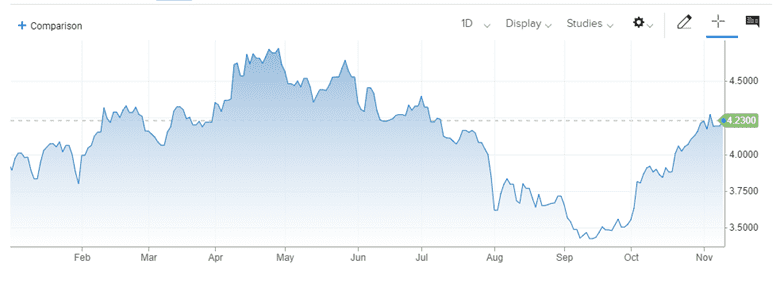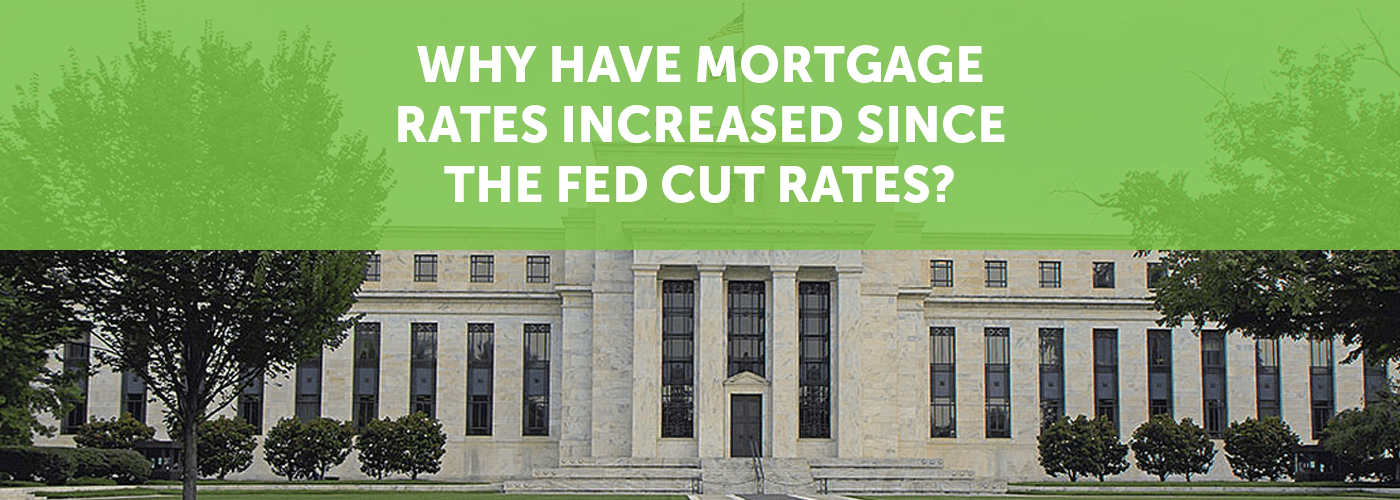Many people are asking why mortgage rates have increased – by a lot – since the Federal Reserve lowered interest rates on September 19, 2024. This cut, the first one in over four years, and a “double cut” (50 basis points instead of 25) led many in the real estate world and great financial economy to rejoice. Rates were finally supposed to move down after a long period of stubbornly high mortgage rates.
Real Estate Investors, many of whom were sitting on the sidelines the past couple of years, as DSCR Loan Rates, or rates for the most popular mortgage loan option for buying rental properties, remained high, sitting in the 7% to 9% range through most of 2022 and 2023, and even touching double digits for some borrowers. The DSCR Loan rates of 2020 and 2021, when the Federal Reserve kept their rates at or near zero, were around 4 to 5 percent, making the numbers work terrifically for real estate investors scooping up properties yielding high rents and low financing costs.
DSCR Loan Rates, which typically trade about 2.5% to 3% higher than the US Five Year Treasury Bond, started to rise again after falling all summer. As you can see in the chart below, the Federal Reserve rate cut, treasury yields marched straight up and to the right – dramatically increasing, and DSCR loan rates followed suit.

Why Have DSCR Loan Interest Rates Risen Since the Fed Cut Rates?#
The bond market is a global market trading in trillions of dollars with many actors and with so many pieces and moving parts, its impossible to pinpoint all the different factors for market movement. However, heres some reasons why many economists and market watchers believe mortgage rates have risen (alongside treasury bond yields).
Fed Rate Decisions are typically “Priced In;” Not Reactive#
The Federal Reserve sets the “Federal Funds Rate,” which is simply a target interest rate for commercial banks to borrow and lend to each other on an overnight basis. While other financial rates are connected to this one rate controlled by the Fed, its not direct.
Sophisticated bond pricing models and a strong belief that the Federal Reserve engages in a policy to telegraph decisions well ahead of time; both through frequent speaking engagements by Fed voters and rumored leaks to the media, mean that by the time the Federal Reserve actually announces a rate decision; market pricing futures can predict it near 100% accuracy.
Thus, the recent 50 bps rate cut on September 18, 2024 and an additional 25 bps rate cut on November 7, 2024 were already predicted by the markets well ahead of time and thus priced into the sophisticated rate setting models by mortgage lenders; including DSCR Lenders when determining rates for new loans.
Thus; Economic Events Since The Cuts Have Indicated Lesser or No Cuts in the Future#
Since the bond yields and mortgage rates essentially move on expectations of future Federal Reserve activity, the economic events since the cuts were made (which had already been priced in); shifted expectations that in future Federal Reserve meetings (particularly December 18, 2024 and January 29, 2025) from further significant cuts to lighter cuts or even another “pause” ahead.
As this article described (and as explained thoroughly in the videos and updates below); key economic data indicators such as the CPI Report and Unemployment Reports and other Jobs Data Releases have the biggest effects on mortgage rates. Generally, market data that shows inflation receding and a weakening job market showing increased unemployment or jobless claims move DSCR loan rates down (as traders anticipate larger and more frequent Fed cuts); while elevated inflation and a stronger job market has the opposite effect. And always important to note; its primarily about the actual data versus market expectations than anything else. As surprises (up or down) for consensus among Wall Street analysts matters more than month over month or year over year changes in most cases.
One of the key catalysts for mortgage rates increasing in October 2024 despite the Federal Reserve cutting rates in September was the September 2024 Jobs report that was published on October 4, 2024. The BLS reported an estimated addition of 254,000 jobs and 4.1% unemployment rate versus consensus expectation of just a 140,000 gain and an unemployment rate of 4.2%.
Additionally, the monthly CPI Report for September 2024, released a week later on October 10, 2024 showed inflation increasing to 2.4%, above expectations, with additional “core” and more granular metrics also more than expected. This steady stream of data showing higher than expected inflation and a stronger than expected jobs market tampered expectations of future Fed cuts over the next few months and contributed to the big jumps in mortgage rates (trading alongside the big jumps in treasury yields).
The “Trump Trade” – Treasury Yields and Mortgage Rates Increase with Trumps’ Election Odds?#
As the 2024 US Presidential Election heated up in October, some market observers began to note a correlation between President Trump’s odds of victory and rising treasury yields (and thus rising mortgage rates). The alleged theory was that “because Republicans may introduce tax cuts and steep tariffs, which could spark economic growth but also widen the fiscal deficit and reignite inflation,” noted CNBC. Indeed, as the Kamala Harris campaign floundered through disastrous appearances and faltering support, as the odds Trump would secure the Presidency rose steadily throughout October, mortgage rates unfortunately followed suit. Even a disastrous jobs report released on November 1, 2024, the Friday before the election showing a increase of just 12,000 additional jobs (lowest in years and sharply below expectations), didn’t pause yields and rates from rising, as Trump’s victory looked more and more assured. However, its important to note that many of these fears may be overblown, as many hysterical predictions of economic doom following Trump’s 2016 victory proved to be wildly off the mark.
After President Trump secured a dominant victory on November 6, 2024 yields continued to stay elevated and many DSCR Lenders approached the election aftermath cautiously, keeping rates relatively stable as it appears that a contentious post-election scenario fades from view following the clear results.
What’s Next for DSCR Loan Rates in 2025 (and the rest of the year)?#
While nobody can predict the movement of interest rates for certain, there is reason to believe that as the election fades into memory and the political climate settles down, interest rates should begin to resume their downward trend; thus reigniting the real estate market and overall economy.
While it is far from certain, here are some reasons to be optimistic for lower mortgage rates in 2025:
The Math#
The US Federal Government deficit continues to grow at extraordinary rates and alongside it, interest expense as well. With interest rates on treasuries still elevated, and many bonds needing to be refinanced (with a lot from lower rate bonds to newly higher rate bonds), the government interest expense will increasingly reach dangerous levels (it has already passed $1,000,000,000,000 in 2024 alone!). While many are optimistic that President Trump’s economic agenda will spur growth and reign in out-of-control spending, the situation is still dire. One of the only quick and impactful ways to aid in the issue is lower interest rates and re-emerging quantitative easing, which will likely mean rapid Fed rate cuts with mortgage rates and DSCR loan rates following suit.
Global Peace & Reconciliation = Lower Mortgage Rates?#
When mortgage rates spiked in 2022 it was well communicated that a primary driver of the upward trend was increasing inflation and the response of the Federal Reserve (drastically increasing the Federal Funds Rate). However, it is not as well known that the Russian-Ukraine War that broke out in spring 2022 also affected the mortgage markets. Ill-fated decisions by the United States and other countries to impose financial sanctions and destabilize financial markets by targeting Russians (including those not involved in military decision making) disrupted the global bond market, removing large swathes of buyers (including in Russia) and pushing bond prices lower, and thus interest rates higher. With President-Elect Trump indicating a peaceful end to this conflict is likely in the cards in early 2025, a potential less-talked-about headwind for mortgage rates might be a friendly reconciliation towards countries (and their investment capital) that had left the market the last few years.
Economic Data#
While the dreadful jobs report released on November 1, 2024 seemingly got pushed to the side by market participants, there do appear to be lots of warning signs indicating a potentially challenged jobs market heading into next year. Additionally, while inflation in some measures has been ticking up a bit, it still sits way below the elevated heights of 2021 and 2022, which spurred the previous rate hike cycle. All in all, the data is not clear and should continue to affect rates significantly moving forward; however nothing strongly indicates a return of super-high inflation or a super-hot jobs market that would cause a reversal of the just-started cutting cycle.
Stay Tuned for more Mortgage Rate Updates#
As DSCR Loan rates move up and down, one thing that stays consistent is that Easy Street Capital has some of the lowest DSCR Loan rates in the industry, consistently providing investors with competitive financing options for the purchases and refinances of rental properties!
Interested in getting some rate quotes or just simply want to learn more or talk to a DSCR Loan expert? Click on quick links below:


